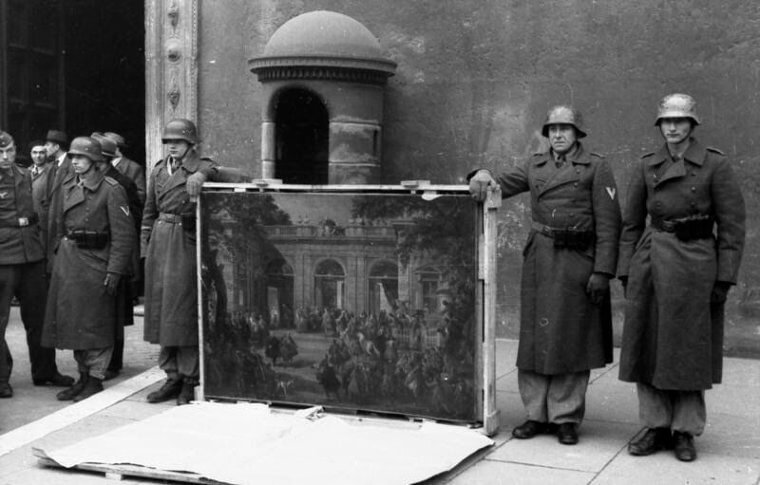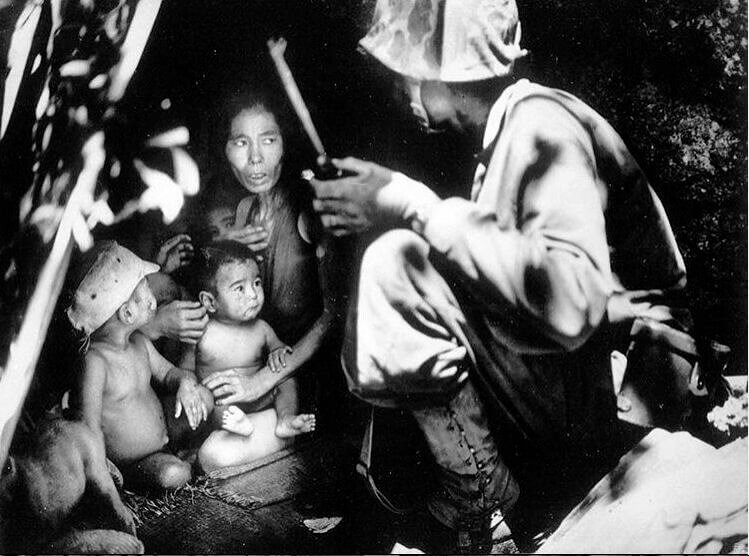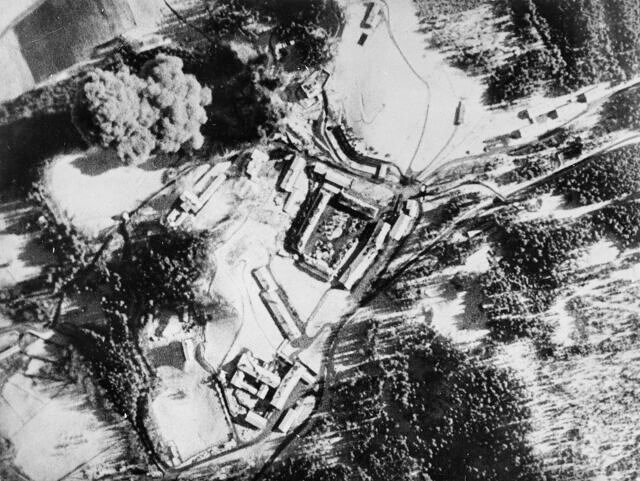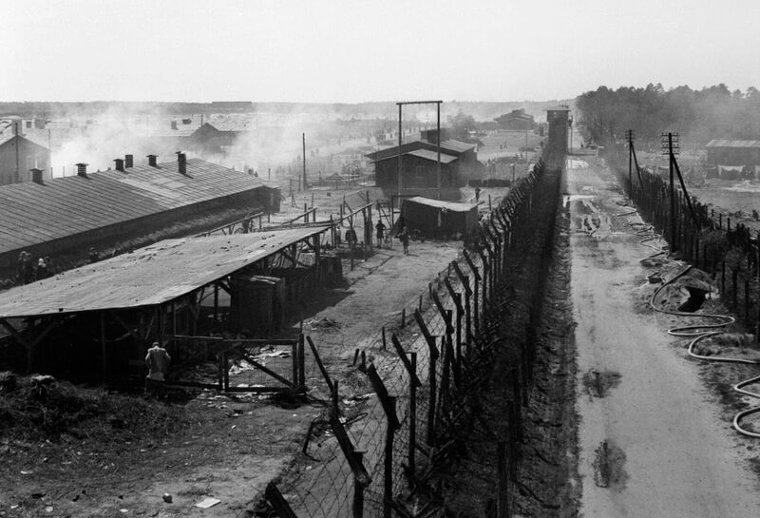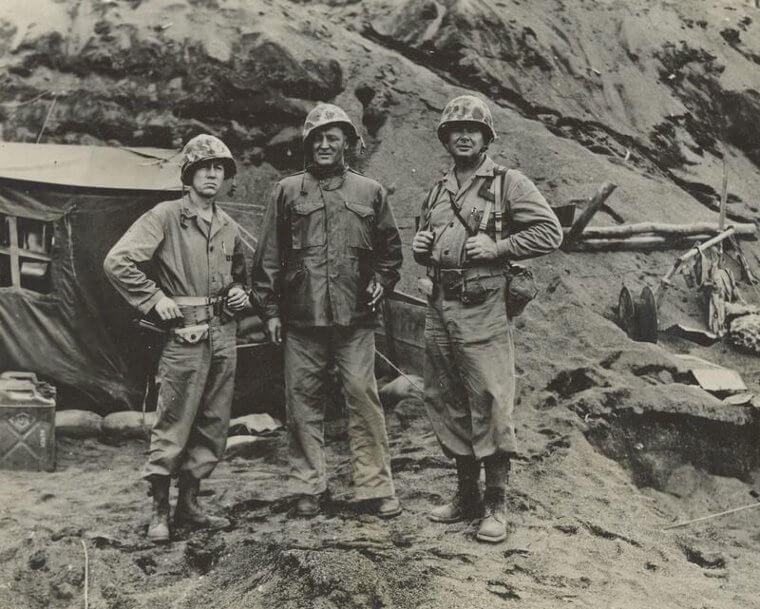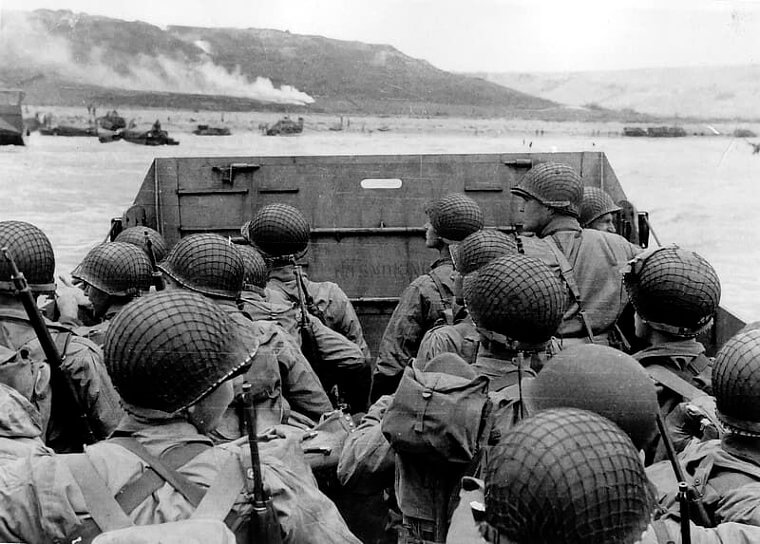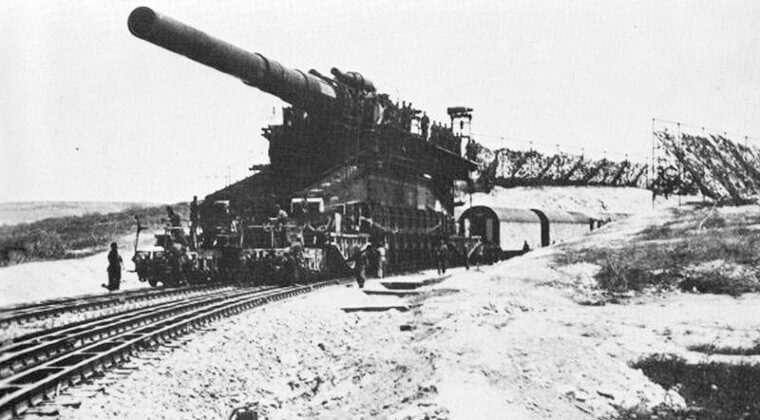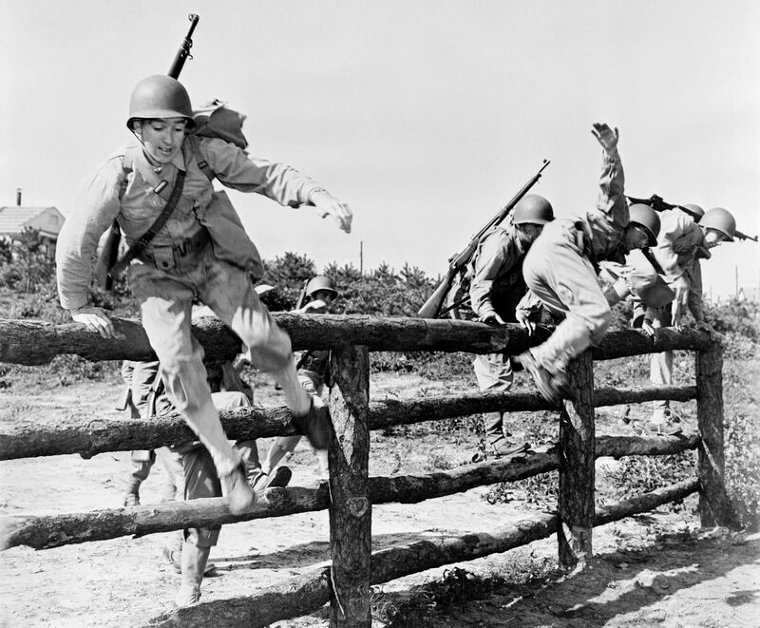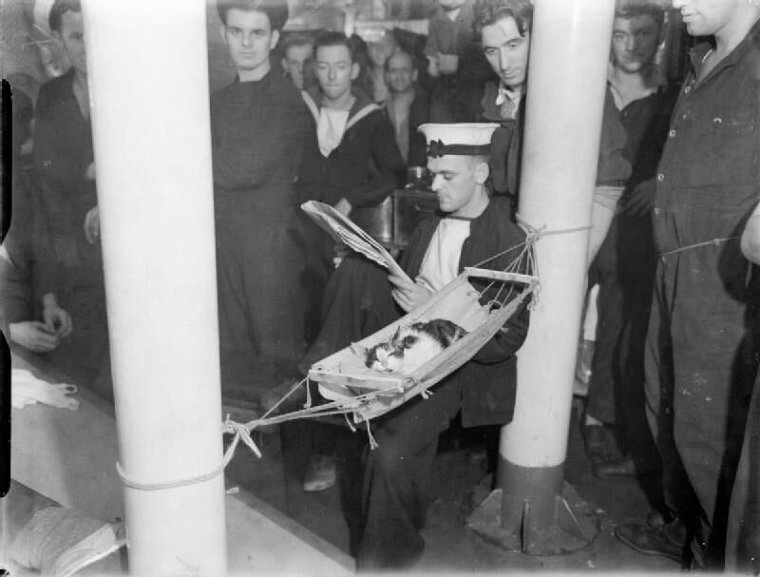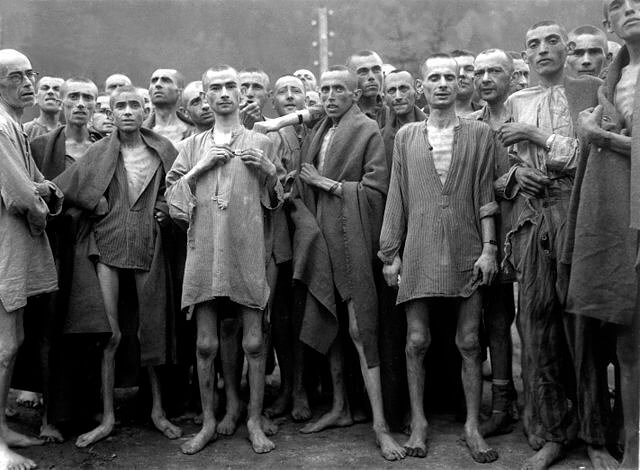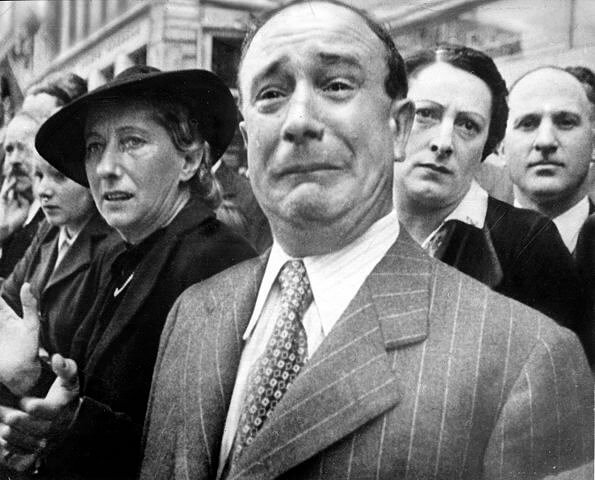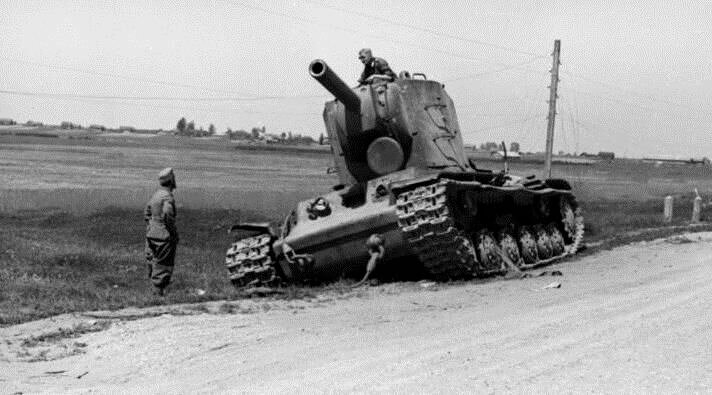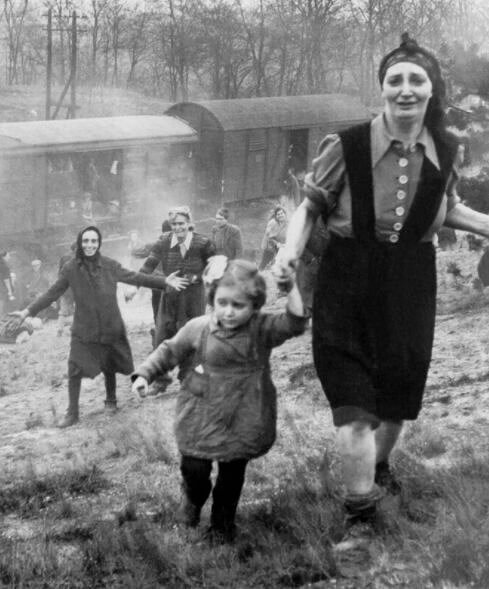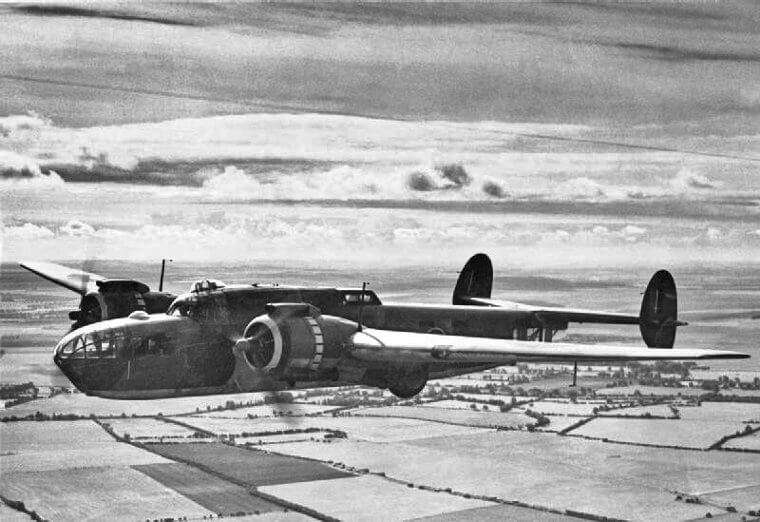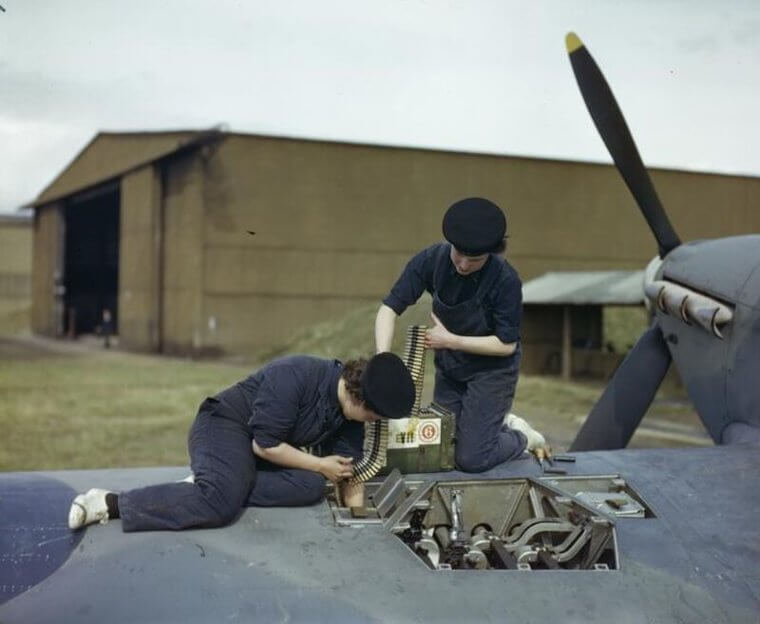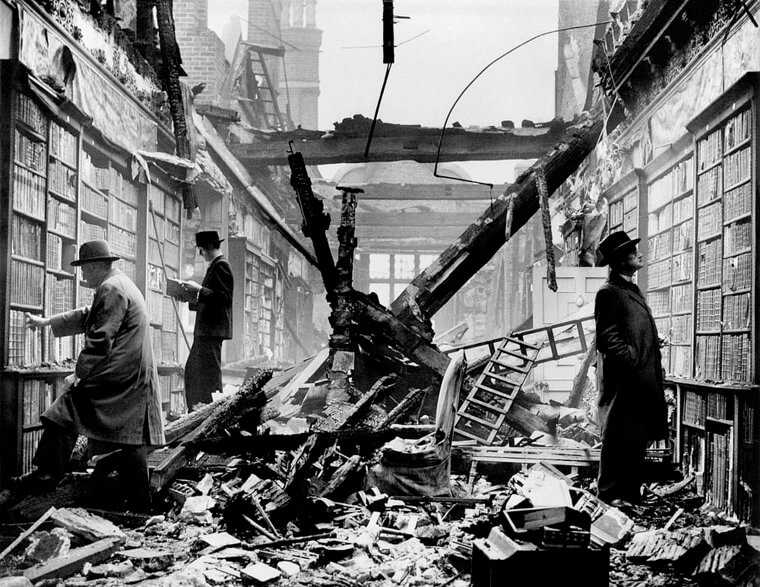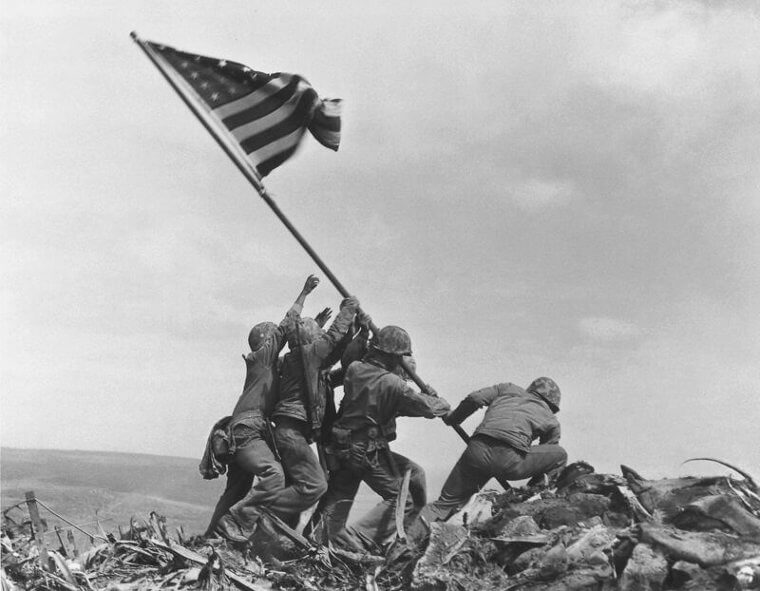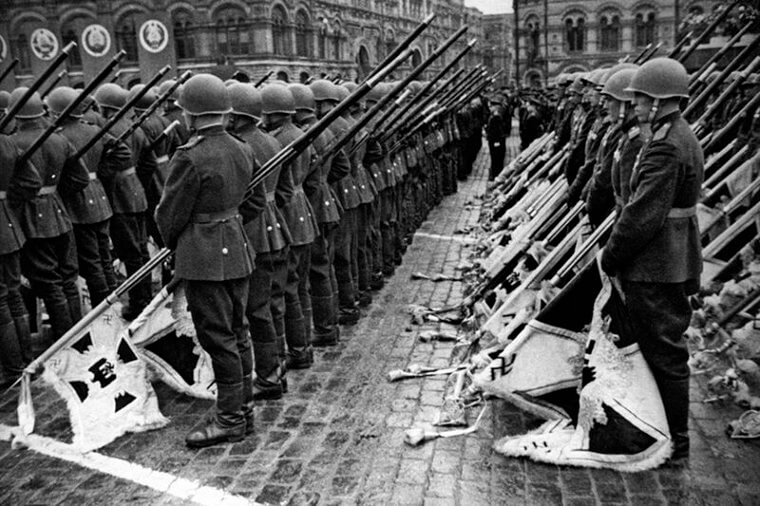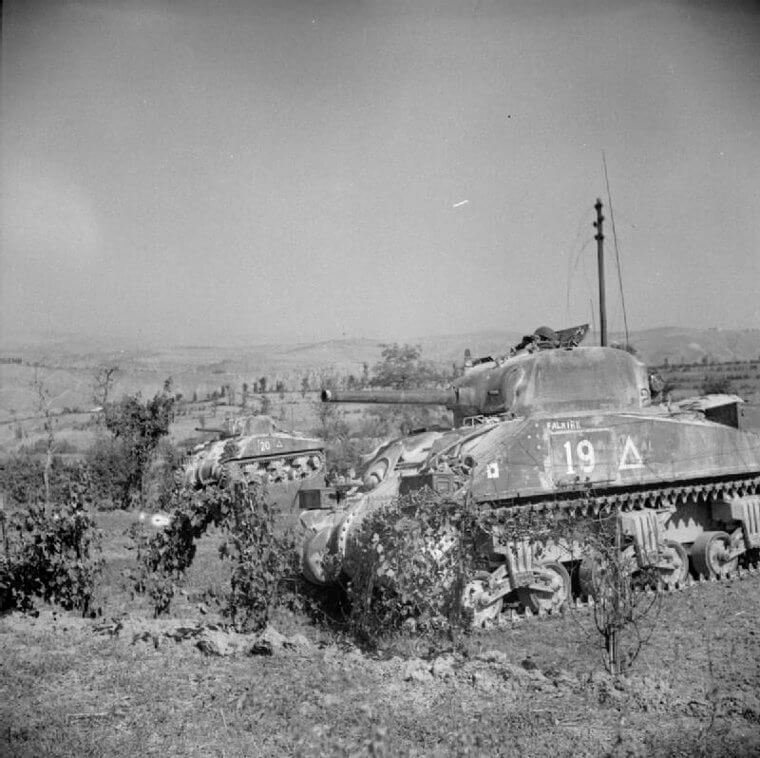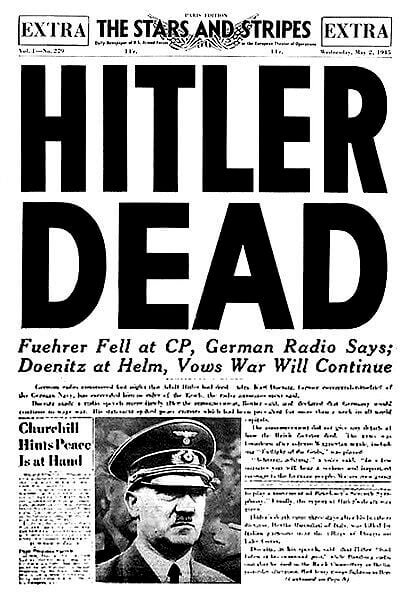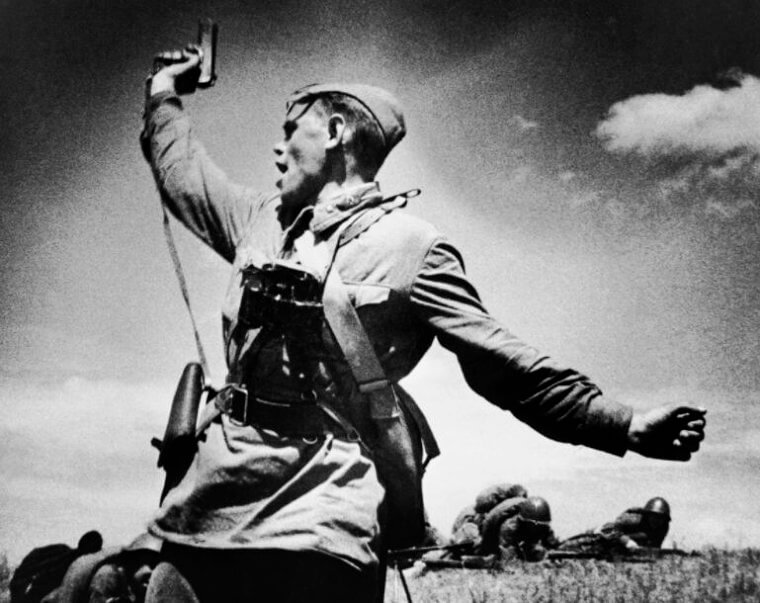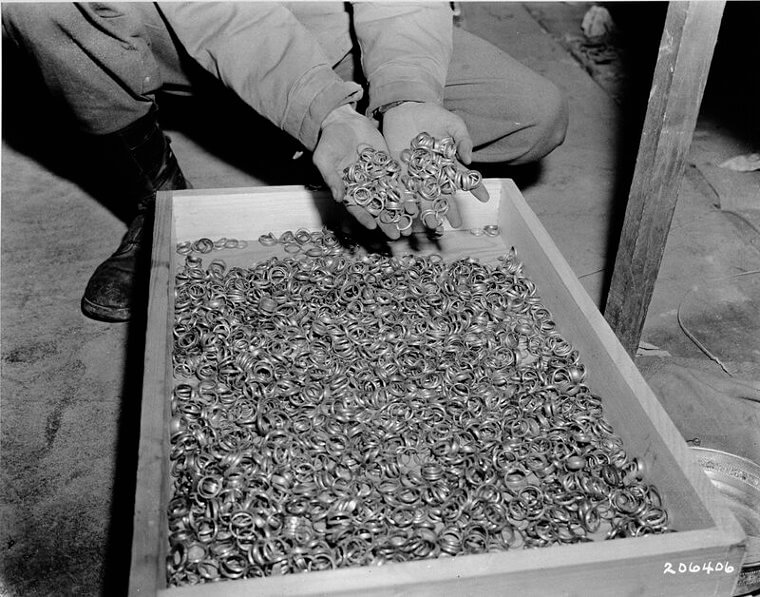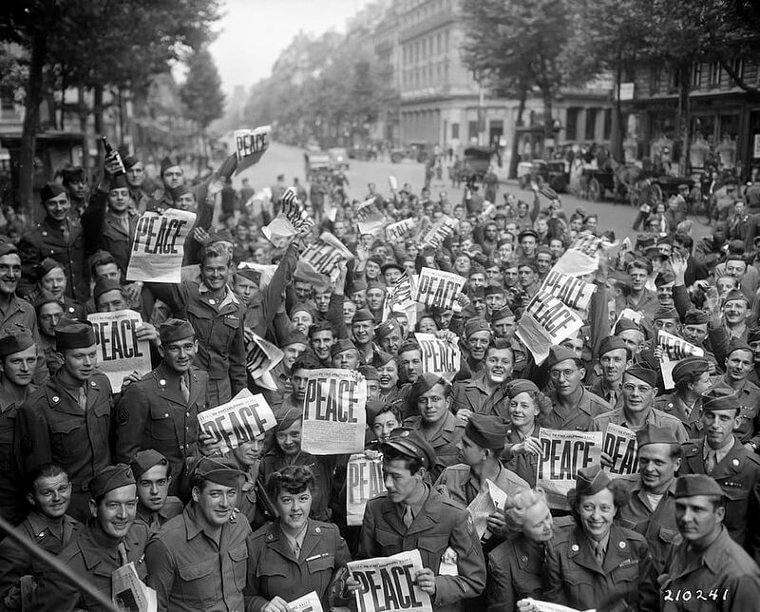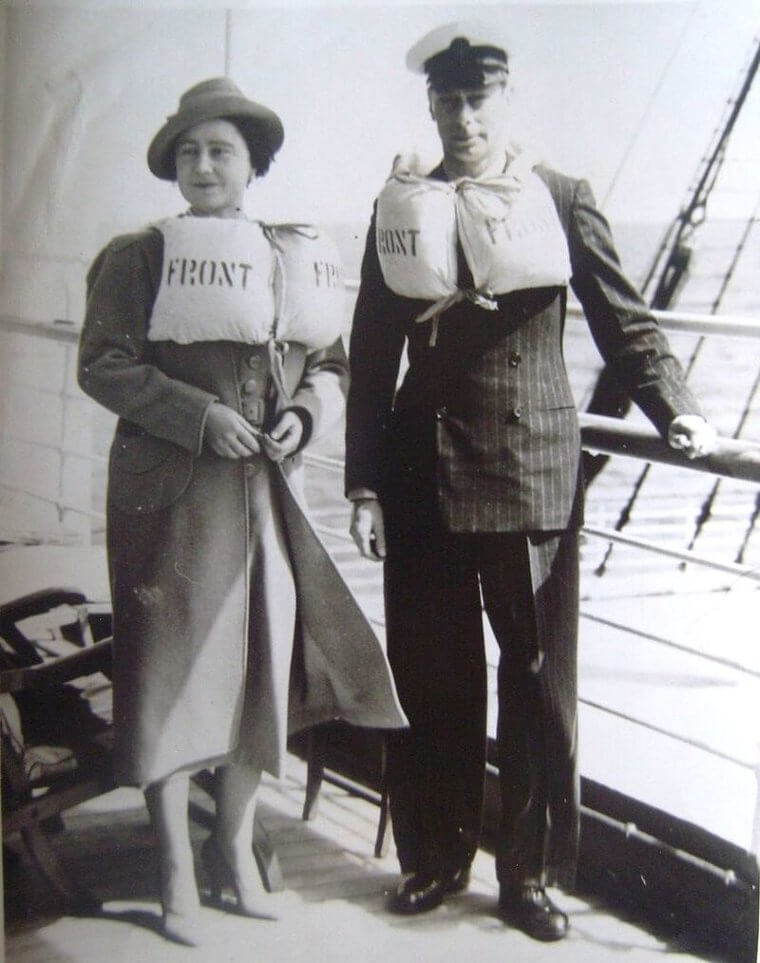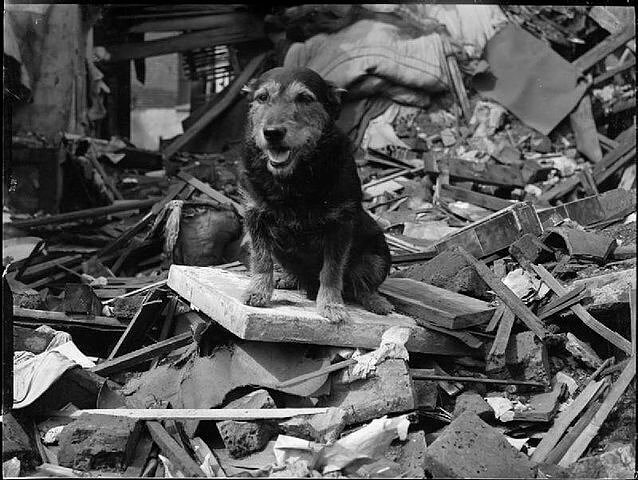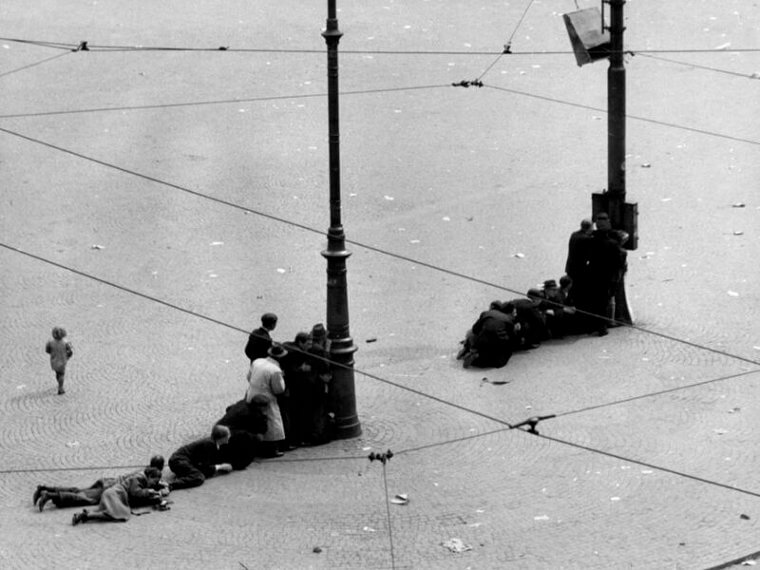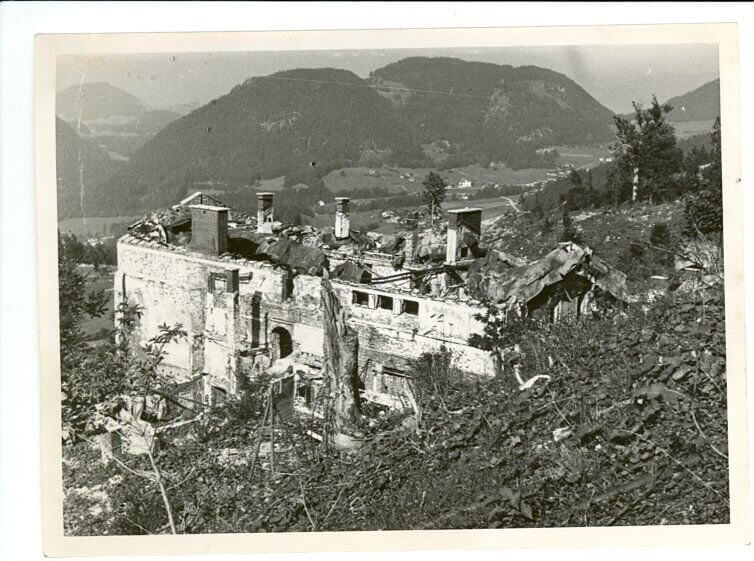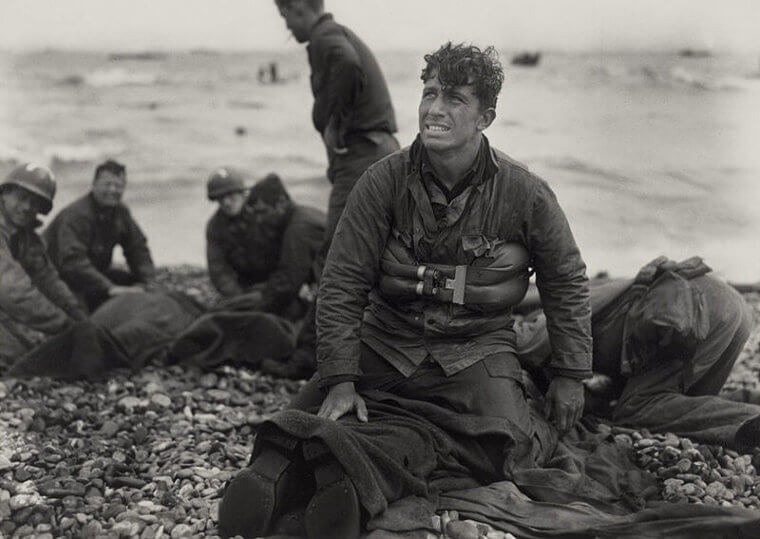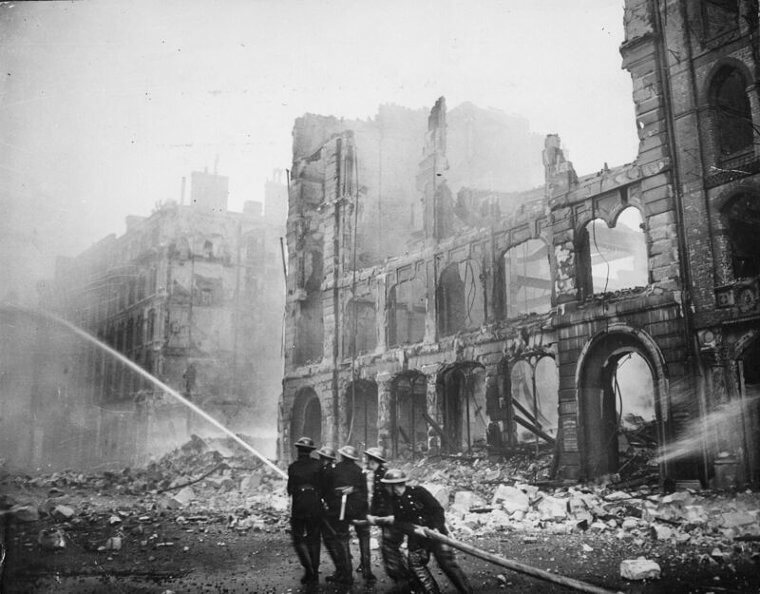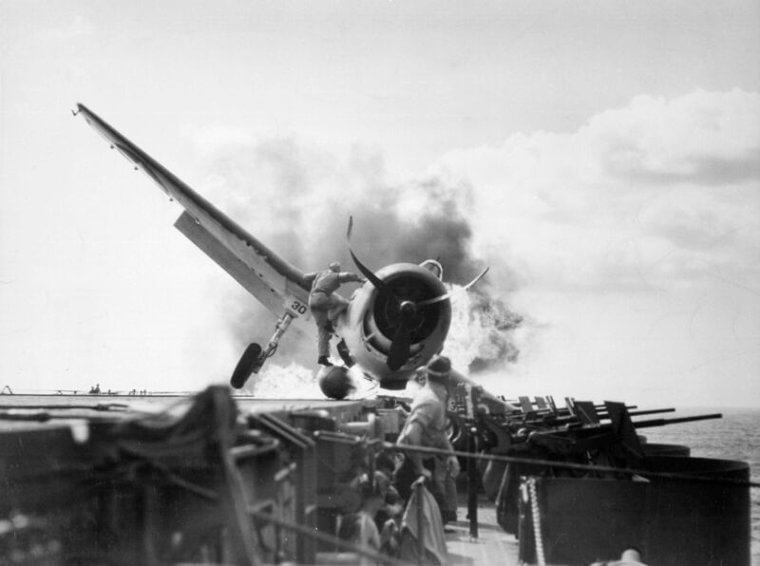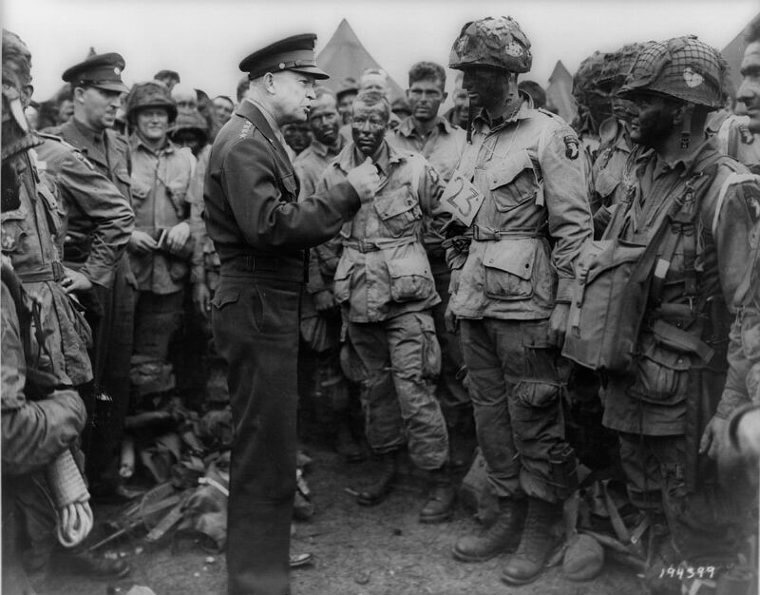If there's one historical event that humanity remembers, then it's World War II. In this article, you will get a chance to see a gallery of photographs taken during that infamous era. There's a high possibility that you have never encountered these astonishing photographs from the war before.
The Collection of Hermann Goering
Hermann Goering was a Nazi officer who collected art pieces and artifacts. Apart from an avid art collector, he was also a political leader and a convicted war criminal. During the period when Germany wanted to dominate Europe, the Nazis created a widespread campaign that allowed them to raid art galleries.
The campaign's name was a Nazi plunder that started in 1933 and ended when World War II came to an end. In this picture, some German soldiers pose with one of Hermann Goering's stolen artwork.
Read on to discover what's in the next picture.
Read on to discover what's in the next picture.
Helping Civilians
Mass propaganda campaigns have significantly contributed to the brainwashing of the Japanese population. The community believed that Americans were the ones who were bloodthirsty and violent. Here you can see an American soldier who is trying to help a Japanese woman and her baby.
When Japan lost the war, the American soldiers led the Allies to provide help for the civilians. Between the years 1945 and 1952, General Douglas A. MacArthur made widespread economic, military, and political reforms.
Hitler's Refuge Place
If there's one thing that Hitler loved, it was new and exciting things related to art and architecture. One thing that he enjoyed was his retreat house. The Berghof residence was Adolf's home in Bavaria, Germany. He spent most of his time there during World War II, and it became one of his official headquarters.
Yet, an American bomber plane destroyed the estate in 1945, and the Bavarian government demolished it in 1952. The photo doesn't do justice to the famous estate in the Berchtesgaden hills that it once was.
The next picture will leave you speechless.
The next picture will leave you speechless.
Setting the Belsen Concentration Camp on Fire
April 15, 1945, marks the liberation of the Belsen Concentration Camp. British troops liberated this camp first. When the soldiers arrived at Belsen, they couldn't believe their eyes. The concentration camp was full of dead and dying prisoners. More than 60 000 people suffered from various diseases, such as typhus, tuberculosis, and dysentery.
Although the medical staff offered immediate help, many prisoners died after the liberation of the camp. A British general ordered his soldiers to burn down the tent, due to poor sanitation. They set the last hut on fire on May 21, 1945.
A Moment of Silence
The US Marine Corps soldiers played a vital role in World War II. More than 600 000 Americans served in the Army. One of the most famous Marine engagements was the Battle of Iwo Jima. It began on February 19, 1945.
Although successful, more than 26 000 US soldiers died in this battle. In this image, you can see three US Marine Corps soldiers taking a break. It was rare to see the soldiers relaxing since they moved from place to place during the war.
Memories From D-Day
The morning of June 6, 1944, marks the D-Day invasion by the Allied forces. They staged a massive attack on the German soldiers deployed on the beaches of Normandy, France. Even though many people think that D-Day is just a famous nickname, others argue that there's a meaning behind it.
Departure, decision, and doomsday are some proposed meanings for the letter D in D-Day. Regardless of the mission's name, more than 150.000 Allied soldiers arrived on France's beaches to liberate the country. In the photo, you can see American soldiers approaching Omaha beach in Normandy on D-Day.
Colorized Photographs
Many of the photographs that date from World War II are black and white. Yet, some in color. A significant number of photos were in color after the war ended. There were a few flight photographers who weren't scared to capture World War II moments from their aircraft in this rare photo.
The bravery that these photographers had is beyond words. Thanks to them, we can get a clear picture of the different struggles that people endured during the hard times.
Germany's Artillery Gun
Eager to invade France, Adolf Hitler asked the construction of brand new artillery. The new weapon could penetrate the forts of the French Maginot Line. Its defenses were the only big physical obstacle between the Nazi Army and the Allies.
Gustav Krupp was the artillery gun manufacturer, and he offered it for free to Hitler's Army. His goal was to show its respect towards Hitler and his Army. The railway cannon weighed 1.350 tons and could fire one shell every 30 to 45 minutes.
The Confiscation of the Artillery Gun
There were two guns of this type. The second one was named Dora, which the Nazi Germans deployed it against the Stalingrad. However, the Germans had to withdraw it when the Soviets almost encircled the cannon. Before the war ended, soldiers broke apart the artillery gun.
Here you can see proud American soldiers who pose with Scherer Gustav's innovation. The creation was Nazi Germany's most massive artillery gun. Hitler was always pursuing new and bizarre weaponry that would help him win the war.
Staying in Shape
The American troops began their first formal fitness test in 1942. Millions of men participated in World War II. Not all of them were ready for combat. To get the soldiers prepared for battles, the American Army initiated a physical development program which was part of the training course.
It included a functional fitness intended to provide the American soldiers' strength, mobility, and endurance. Fort Bragg created the Physical Training School. All men from ages 18 to 45 had to register for the training.
Adolf Hitler in France
Once the Nazis entered France, it didn't take long before using the most prominent French monuments for their propaganda. You can see Adolf Hitler in front of the Eiffel Tower, accompanied by other officials.
The architect Albert Speer and the artist Arno Breker were also present when they captured the photo. Adolf Hitler didn't stay long in Paris; his visit was relatively short. However, he praised Paris for being one of the most amazing places he had encountered.
Sleepy Cat
It's not a secret that dogs, cats, pigeons, and horses took an active role in a war. Whether that's providing emotional support or helping to turn battles, the animal kingdom was always present. Pets also give much-needed amusement during hard times.
And whoever said that pets aren't amusing during the war, clearly hadn't seen this photo. You can tell these sailors how they are taking care of this kitten. To provide extra comfort, they even made a bed for their new pet.
Switching Roles
When the Allies finally freed people from the concentration camps, the rescuing soldiers were in great shock. What they saw was beyond what anyone could have ever imagined.
One of the survivors from the Jewish death camp reversed roles with his former captors, and he was the one who had the upper hand after the war. Although the Allies went the extra mile to save the camp inmates, sadly, many Jewish prisoners died because of various diseases and malnutrition.
Keep reading to find out what the next picture is about.
Keep reading to find out what the next picture is about.
Dealing With Severe Pain
The Saar Offensive was a French ground invasion that had almost 40 divisions. The plan was to help Poland, which was under Germany's rule. However, the attack stopped when Germany succeeded in stopping the French troops. Then, the Fall of France or the Battle of France happened on September 3, 1939.
Germany invaded France and the Low Countries during World War II. The French population was left in shock when it realized that the Nazis were about to invade France. This man experienced severe pain when he understood that his hometown was under Nazi control.
The Attack on Pearl Harbor
Americans remember the date of December 7, 1941. On this day, the Imperial Japanese Navy Air Service attacked the naval base at Pearl Harbor. Following the attack, the American army joined the Second World War. Japan planned to prevent American military actions in Southeast Asia.
The Pearl Harbor attack claimed the lives of more than 2000 Americans. Japan's leadership referred to this attack as Operation AI, Operation Z, and Hawaii Operation during the planning stages.
Ineffective Tanks
Nazi Germany pried on having state-of-the-art technology that could win battles. That was true, especially when Gustav Krupp invented the artillery gun. Yet, not all weapons had proven to be successful. The small tanks in this picture represent the opposite.
Although the idea was to control the little containers with remote controls, the mission was not successful. The tanks weren't fast, cost a lot of money, and the soldiers didn't use them at the end. They were ultimately ineffective.
Saved
Nazi Germany had six extermination camps. They were also called death camps or killing centers. The fields were explicitly made to kill people, mostly Jews, mainly using gas, during the Holocaust. However, in the Auschwitz and Majdanek extermination camps, Nazis exploited the prisoners by working under starvation conditions.
Until the very last days of the war, the Nazis used extermination machines to kill people. When the Allied forces came for their rescue, many people were thankful that they avoided their execution. In this image, you can see a Jewish woman and her children walking out of a train. The train was taking them to their killing.
Colonel Anthony Joseph Drexel Biddle
Colonel Anthony Joseph Drexel Biddle trained men in hand-to-hand combat during the World Wars. He was a member of the American Geographical Society. He was also the founder of a movement called "Athletic Christianity."
This movement attracted over 300.000 members from different countries. He was popular among soldiers. There is a story that he convinced Marines to try and kill him with bayonets. However, this was unsuccessful, as the colonel disarmed them all. Sports Illustrated wrote that he was "boxing's greatest amateur."
In the Air
August 3, 1942, marks the date when the 295th Squadron of the Royal Air Force was created. The Squadron was the first unit to have the Armstrong Whitworth Albemarle transport. It also included a glider tug aircraft.
The group was supposed to drop leaflets into France while World War II lasted. The photo dates back from October 1942. In 1943, the unit changed to the Albemarle MK.I. It was the first aircraft to drop soldiers over Normandy, on the evening of D-Day.
Supplying the Airplanes
The Women's Royal Naval Service (WRNS), officially known as Wrens, became famous in 1917 during the First World War. However, the service said its goodbyes in 1919. At the beginning of the Second World War, in 1939, Wrens came back to life.
The British Women's Royal Naval Service remained active until integrated into the Royal Naval in 1993. You can see two women supplying the airplane before it takes off to perform attack missions in this colorized photograph.
Book Worms
People felt the effects of the Second World War long after it ended. British citizens didn't stop with what they love to do best. Many nightly bombing attacks destroyed a large number of British cities. Its citizens got used to the "Blitz."
Yet, many book lovers didn't give up on books. Even when the bombings destroyed the library, these avid readers stopped by to see what was left. The books prevailed, so the readers stopped by to check for more titles.
Iwo Jama Island
One of the most significant battles that occurred in World War II was the Battle of Iwo Jama. It started on February 19, 1945, and lasted until March 26, 1945. Operation Detachment, organized by the American soldiers, had the purpose of taking over the island with two airfields. The plan was for the island to serve as a starting point for attacking the Japanese islands.
The photograph represents the symbol of American win in the Pacific. American soldiers joined all together to put the flag on Mount Suribachi on the Iwo Jama island. The battle lasted for five weeks, since the Japanese troops hid in the mountain, posing a great difficulty for the American Army.
Moscow Festivities
After the costly war ended, it was time for a celebration. Moscow, the Soviet capital, decided to run many festivities to celebrate the soldiers and civilians who lost their lives in the costly World War II.
Another grand celebration that took part in Moscow was the Moscow Victory Parade of 1945. The Soviet Armed Forces organized the parade to celebrate the defeat of Nazi Germany. The celebratory parade was the most significant military parade ever held on Red Square.
Escaping From the Sniper
In World War II, both the United States and the Western Allies used medium tanks, also known as M4 Sherman tanks. The tanks were reliable and cheap to purchase. The Lend-Lease program allowed the British Commonwealth and Soviet Union to handle tens of thousands of Sherman tanks.
The vehicle's name comes from the British paying its respects to the American Civil War general William Tecumseh Sherman. Yet, the Nazi snipers had excellent skills. You can see a Sherman tank providing cover for soldiers in this image as they escape from a German sniper.
Visiting Egypt From Above
North Africa had one of the most vital roles in World War II. The North African importance was due to the North African Campaign, which began in June 1940 and lasted until 1943. The Axis and Allied forces fought back and forth in the desert.
When the war started, Libya was an Italian colony for several decades. British forces, on the other hand, colonized Egypt since 1882. When Italy declared war on the Allies in 1940, the two armies started fighting over the North African region. This awesome image represents an Allied plane, making a flight over the Pyramids in Egypt.
Der Furher's's Death
The date of April 30, 1945, goes forever in history. Adolf Hitler committed suicide on this day. Soon after he married Eva Braun, he decided to take his own life by drinking cyanide first and then shooting himself with a pistol.
Devasted that his 1,000-year Reich collapsed above him, he retrieved to an air-raid bunker, accompanied by his wife. The shelter contained 18 small self-sufficient rooms. To everyone's surprise, the German Embassy in Sweden mourned his death by lowering the flag.
A Leader Worth Remembering
The only country that was able to stop the Nazi invasion tactic was Russia. The name of the Nazi invasion tactic was "Blitzkrieg." It described a method of offensive fighting, and it included both armored tanks and air support.
The technique led to a quick win, limiting the number of killed soldiers and used artillery. Even though the "Blitzkrieg" method proved to be successful, the Russians succeeded in holding back the enemy from coming to Moscow. The brave and courageous Russian lieutenant on this photograph is leading his soldiers into battle against Nazi Germans.
Nazi Plunder
The Nazi Germans went to another level when it came to stealing someone else's possessions. The loot started with creating a new law titled "Decree for the Reporting of Jewish-Owned Property." Adolf Hitler issued this law on April 26, 1938. It required all Jews to register their property and assets, valued at more than 5.000 Reichsmarks.
The registry included furniture, artwork, life insurance, and stocks. On July 31, the German officials collected the paperwork from more than 500.000 Jews the same year. Stealing jewelry from the Jews was also part of the theft. Here you can see many wedding rings stolen from the Jews.
Festivities in NYC
Even when World War II started, the Americans didn't intend to join the Allied forces. They preferred to remain isolated and not take part in the fighting on the other side of the Atlantic.
However, many changed their minds once the Japanese troops attacked Pearl Harbor. Following the attack, the United States Army took part in the war until the very end. In this image, you can see joyful New Yorkers celebrating the end of the war.
The Queen of Britain
The British government believed in the idea that every citizen should get involved in the war. The 18-year-old British princess, Elizabeth, wasn't an exception either. After months of begging her father to help, Elizabeth Windsor joined the Women's Auxiliary Territorial Service during World War II.
She put on a pair of overalls and trained in London to be a military truck driver and a mechanic. Today's Queen Elizabeth remains the only living head of state who took an active part in the war.
A Brave Dog
Every British citizen wanted to help in one way or another during the war. Whoever said that only humans offered help was wrong. The search and rescue dog in this image, Rip, was a brave helper in finding bombing raid victims.
An Air Raid Warden found Rip in Poplar, London, in 1940, and soon became the first search and rescue dog. The courageous mixed-breed terrier saved over 100 people and was awarded the Dicking Medal for bravery in 1945.
Hiding Places
During the Second World War, many Dutch Jews perished faster than any other West European citizens. The Jew community numbered around 150.000 people, including Jews who moved to the Netherlands. Most of them came from Germany since 110.000 were deported. Although only 5.000 returned, many Jews survived while hiding in the Netherlands or the other countries.
The Nazi Germans were nothing but cruel with them, as you can see from the photograph. Regardless of the nationality, these citizens try to hide from the Nazi soldiers but without success.
Prized Estate
The Eagle's Nest, also known as the Kehisteinhaus, is a building that dates from the Third-Reich era. The building locates on the top of Kehlstein, near the town of Berchtesgaden. The Nazi Party members used the Eagle's Nest the most for government and social meetings.
Adolf Hitler visited the place more than ten times. He didn't like the location, as he had a fear of heights. Nowadays, the building operates as a restaurant, beer garden, and tourist attraction. In this image, you can see the American troops relaxing after expelling the oppressor.
The Defender
The Nazi Germans implemented the yellow star to identify and humiliate Jews publicly. The Reich Minister was the one who issued the decree for Jews to wear the yellow Star of David on their clothes.
The public identification led to thousands of Jews being deported to killing sites, concentration camps, and ghettos. Exploitation and starvation were normal. The photograph shows a brave Muslim woman helping a Jewish woman by hiding her yellow star and protecting her from the enemy.
Bad Weather Conditions
One of the biggest D-Day battles happened on Omaha Beach. It was ten kilometers long, located between the fishing port of Port-en-Bessin on the east side, and the mouth of the Vire Rivers on the west.
However, the planned Allied attack had to happen one day later, on June 6, 1944. The reason was bad weather. The image depicts improved weather, just on the day of the grand attack. If hell exists, then it would be like this.
Putting Out the Fire
Baby Blitz was a strategic bombing campaign organized by the German Air Force (the Luftwaffe) during World War II. It was also known as Operation Steinbock that targeted southern England. It lasted from January to May 1944, and it was the last air attack by the German bomber.
Learning about the planned attack, the Allied Combined Bomber Offensive planned a bombing campaign against Nazi Germany. Regardless of the Allied forces planning, Adolf Hitler ordered the Air Force to attack London. Here, the firefighters are putting out the fire after the air raid.
Aircraft Landing
Ensign Byron M. Johnson was the F6F Hellcat pilot that crashed onto the deck of the USS Enterprise. The airplane was en route to attack one of the Gilbert Islands. Many people described it as a war-winning weapon developed to improve the existing F4F Wildcat German plane
Ensign managed to escape the aircraft crash safely, which happened on November 2, 1943. A central feature of the massive war was the constant race for a new weapons technology.
Pep Talk
Dwight David Eisenhower was an American Army general and the 34th president of the US. He was a president from 1953 to 1961. During World War II, he got a new title, a five star general in the Army. Apart from his general position, Eisenhower was also a Supreme Commander of the Allied Expeditionary Force in Europe.
The most notable function he held was coming up with a plan and supervising the invasion of North Africa in 1943. Dwight D. Eisenhower was responsible for the successful invasion of Normandy. In this image, he talks with the troops making sure they feel brave and encouraged for the upcoming battle.
The Haka Dance
The haka dance is a traditional Māori dance or challenge. A group of dancers dances, showcasing the pride, dignity, and uniqueness of the tribe. The dance includes stamping with the feet, tongue protrusions, and accompanying a loud chant; the dancers incorporate a rhythmic body slapping.
The haka song’s lyrics describe the ancestors and the most popular events of the tribe’s history. Due to the Commonwealth, many soldiers from different colonies participated in World War II. Some of them were from the Māori in New Zealand.
Coming to Terms With Defeat
The Soviet city, named Kursk, is the place where Russia and German had a turning point in the war in the east. Hitler launched Operation Citadel following the terrible defeat at the Battle of Stalingrad by the Soviet Red Army. The Battle of Kursk was Hitler’s last chance to control the Eastern Front during World War II.
He was hoping the attack would be the Army’s final blitzkrieg offensive. However, his plan ultimately failed. In the image, the German troops are coming to terms with the fact that they would soon become prisoners of war.

